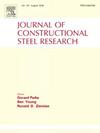含点蚀的CFST圆形短柱轴压特性
IF 4
2区 工程技术
Q1 CONSTRUCTION & BUILDING TECHNOLOGY
引用次数: 0
摘要
钢管混凝土(CFST)构件以其优越的力学性能、显著的经济效益和施工方便,广泛应用于各种结构应用中。然而,这些构件在使用过程中很容易受到腐蚀,特别是局部点蚀,这通常发生在钢管上,并导致严重的损坏。研究了含点蚀的圆形钢管混凝土短柱的轴压性能。首先对12个试样进行了点蚀试验,通过加工缺陷实现了点蚀。其次,建立了相应构件的有限元模型,并通过实验验证了模型的可靠性。为了考虑局部腐蚀的随机性,进行了详细的参数分析,探讨了体积损失、腐蚀深度、钢比和材料强度等各种因素对柱轴压性能的影响。基于试验和有限元分析结果,建立了具有局部点蚀的圆形钢管混凝土承载能力的确定方法,为实际工程应用中锈蚀的钢管混凝土构件的评估和加固提供了有价值的见解。本文章由计算机程序翻译,如有差异,请以英文原文为准。
Axial compressive behavior of circular CFST stub columns with pitting corrosion
Concrete-filled steel tube (CFST) members are extensively employed in diverse structural applications due to their superior mechanical properties, remarkable economic benefits and construction convenience. However, these members are susceptible to corrosion during service, particularly local pitting corrosion, which typically occurs on the steel tube and causes substantial damage. This study investigates the axial compressive performance of circular CFST stub columns with pitting corrosion. Firstly, 12 specimens were tested and pitting corrosion was achieved by machining defects. Next, the finite element (FE) model of corresponding members was created, and the model's reliability was validated against the experimental observations. To account for the randomness of local corrosion, a detailed parametric analysis was conducted to explore the effects of various factors such as volume loss, corrosion depth, steel ratio and material strength on the axial compressive behavior of the columns. Based on both experimental and FE analysis results, a method for determining the bearing capacity of circular CFST with local pitting corrosion was developed, providing valuable insights for the evaluation and strengthening of corroded CFST members in practical engineering applications.
求助全文
通过发布文献求助,成功后即可免费获取论文全文。
去求助
来源期刊

Journal of Constructional Steel Research
工程技术-工程:土木
CiteScore
7.90
自引率
19.50%
发文量
550
审稿时长
46 days
期刊介绍:
The Journal of Constructional Steel Research provides an international forum for the presentation and discussion of the latest developments in structural steel research and their applications. It is aimed not only at researchers but also at those likely to be most affected by research results, i.e. designers and fabricators. Original papers of a high standard dealing with all aspects of steel research including theoretical and experimental research on elements, assemblages, connection and material properties are considered for publication.
 求助内容:
求助内容: 应助结果提醒方式:
应助结果提醒方式:


